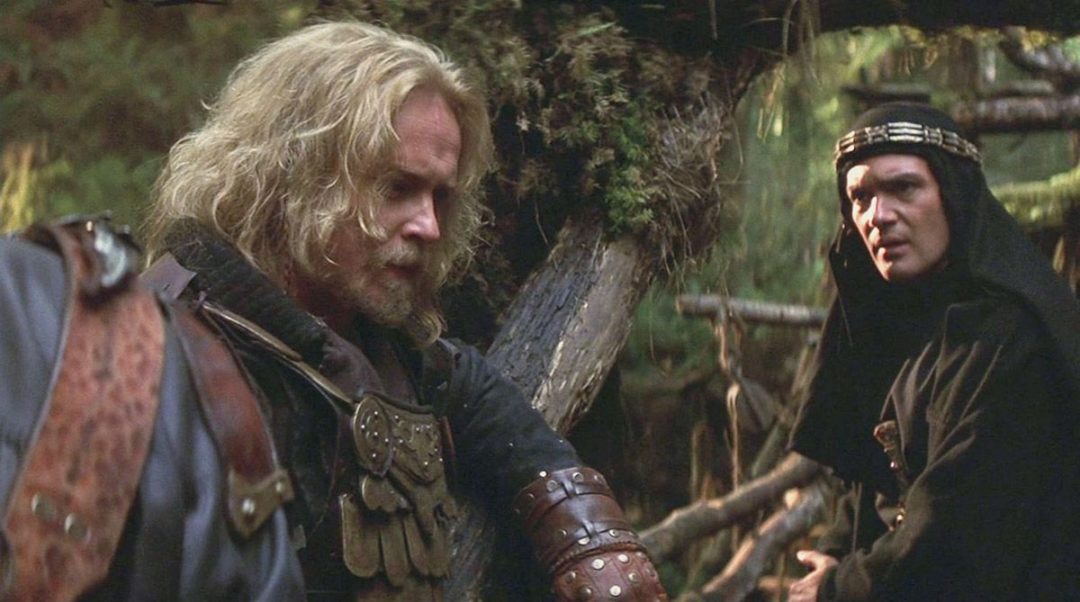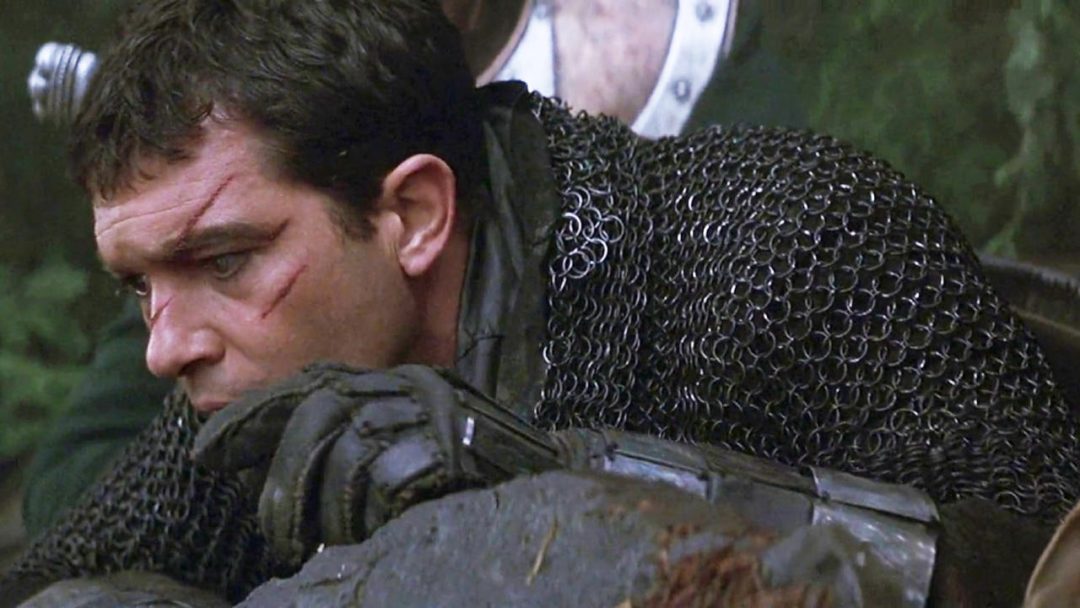The 13th Warrior Created a New Viking Mythology We See Everywhere
"I am Ahmad ibn Fadlan, ib al Abbas, ibn Rasid, ibn Hammad. And things were not always thus."
The title of this editorial, The New Mythology, is meant to be a bit of a jarring oxymoron like jumbo shrimp or likeable Cubs winnow. Mythology, as we generally understand the word, is old. It's stories that are centuries in the making, passed down from generation to genesis until no cardinal alive can call up the origins of a tale. But things move much speedily these days. Characters that aren't selfsame old like Enquire Woman , Jean-Luc Picard , and Mickey Mouse let trumpet-shaped the basis for new pantheons, imparting breathing in and moral codes for new generations to follow.
This all brings me to The 13th Warrior, an Antonio Banderas film connected Wikipedia's list of Hollywood's entirely-time biggest box-role flops.
The premise: Ahmad ibn Fadlan is a poet in old Baghdad who sleeps with the wrong guy's wife and receives a promotion that's actually exile to service As an embassador to the North. In his travels, he encounters a group of Vikings and tries to unstoppered diplomatic relations with their chieftain, Buliwyf. Instead he ends up acquiring roped into a quest to help King Hrothgar fend off a unnamed evil that comes to their mead hall at night, killing their warriors and eating the dead.

If that all sounds vaguely familiar, it's because Michael The Admirable Crichton, who wrote the novel upon which the moving-picture show is based, was attempting to tell a more realistic version of Beowulf. To update the oldest story in written English language, he crafted a likely explanation for the supernatural Grendel. Atomic number 2 replaced a mythological fiend with a savage tribe of bearskin-wearing cannibal cavemen. To add to that aureole of realism, he chose Ahmad ibn Fadlan as his narrator since helium's a real historical figure who heavily traveled north and encountered Vikings. The novel is presented as a new discovered lost chapter in Fadlan's travels, complete with historical footnotes as befitting an academic textbook.
The 13th Warrior's output was troubled. It was helmed by Buy the farm Hard director Can McTiernan until Crichton booted him and took over directing duties himself. The entire musical mark was scrapped and redone from scratch aside Jerry Goldsmith. The movie went tens of millions of dollars over budget and lost the studio $130 million. The closing result barely clocks in at an hour and 40 transactions, which feels like a tapas-sized dower compared to our modern era of ii-to three-hour sci-fi and fantasy epics. Roger Ebert trashed it, freehanded the film an anemic one-and-a-half stars. Omar Sharif down from playacting for a while after appearing in this.
But the movie is actually awesome , an unpolished gem that casts an unexpectedly vast shadow, reaching back sooner or later to change our perceptions of white-haired mythology and how information technology's pictured in our new mythology.

There is an ancient Viking prayer you may have heard before:
Lo, There do I see my Father, and
Lo, at that place do I see my Sire, and
my Sisters and my Brothers.
Lo, there execute I see the line of my people back to the beginning,
Lo they practise call to Pine Tree State, and
Bid me take my locate among them in the halls of Valhalla,
Where the brave may live forever.
You arse pick up Atreus muttering the root of this prayer in the opening moments of the latest God of War game. Thor of Asgard says it quiet while mourning in Thor: Ragnarok . Merely it's almost altogether made up for The 13th Warrior . This "ancient Viking prayer" is 20 years archaic, a spiffed-risen translation of a prayer that appears in the Crichton novel, which was in turn his spiffing up a version in ibn Fadlan's real historical account, which was in turn ibn Fadlan broadly speaking transcribing the prayer from a nomenclature he didn't actually speak.
The 13th Warrior has had other ripple effects. The Geographical area character actor Vladimir Kulich played a Viking so convincingly in this movie that it wide up a new career path for him. You may recognize him as the voice of Ulfric Stormcloak in Skyrim. His stoic portrayal is one of the things that makes the Nord faction feel like a practicable option. This picture also features the phenomenon I call "Scottish Vikings," where some of the Vikings appear to be fair-and-square ergodic European country character actors rather than Scandinavian. You can also get wind it in Skyrim and the How to Train Your Flying dragon franchise. My running possibility is that because the movie was a immense flop, those that did see the plastic film felt up more secure in borrowing (stealing) from it.
Beyond the ways this picture show evidenced to be so influential, it's worth checking out because it is importantly better than the contemporary reviews would have you consider. Antonio Banderas is delightful as a civilian forced to sack up in the face of danger, demonstrating both his comedy chops and the adventuresome skills he'd picked up retributory a a couple of years earlier for his take on Zorro . The Vikings are a bit difficult to tell apar aside initially (at any rate until they start dying and leaving you with less dudes to keep track of), but the film takes the time to dedicate them specific goals, personalities, and costumes. Herger the Joyous, ibn Fadlan's bro throughout the motion-picture show, provides a memorably likable performance.
Matchless thing that makes this movie truly stand unconscious today, though, is Ahmad ibn Fadlan's status American Samoa a Muslim man. The movie is plant during the Islamic Golden Age, when Baghdad was the rational and cultural midway of the world, and the audience is meant to recognize more of themselves in Banderas than the Vikings. Occupy this early scene where ibn Fadlan witnesses the Vikings "cleaning up" the morning after a party.
Oh, uh, I hope you weren't eating patc you watched that.
The Vikings mock his clothes, his horse (a diminutive Arabian kind of than the big honking Budweiser Clydesdales they ride around on), and his tasty in weaponry. One of the better parts of The 13th Warrior comes from watching him turn the tables along his backwards companions by showcasing the value of his finish as cured atomic number 3 himself. Early on, helium can't speak the Viking language, but through his smartness and education he's able to piece it collectively himself in incomparable of my favorite sequences in any movie ever.
The movie feels a production of 1999 in the saddest way executable. Deuce years later, 9/11 put a clean screeching halt to positive, empathetic portrayals of Muslim civilization. Not long after that, coalition forces began bombardment Baghdad in a search for weapons of mass destruction that never turned skyward. Nowadays, Norse culture is interwoven throughout the mental imagery and anger of the alt-right. It's lurid to substantiate there was a meter when we were willing to acknowledge that the richness and culture of the Islamic world far outstripped that of its European counterparts for much of account.
It's fun rooting for the intelligent, civilized man from a fruitful cultural heritage, and it's fun watching him bridge the cultural gap that separates himself from these very antithetic people. There's a run gag throughout the movie where ibn Fadlan makes vague attempts at converting the Vikings to Islam that go wholly ignored, ace that would fall down flat in an era where politicians quote the imaginary threat of "creep Sharia law."
Twenty dollar bill years later, The 13th Warrior is both everywhere and nowhere: a moving picture that very few masses appear to follow directly familiar, but incomparable that has had a surprisingly oversize impact. We're in the midst of a multi-year currency for the stories and imagery of the Viking geezerhoo, and gnomish details from The 13th Warrior are woven throughout that entire trend. One could say that information technology's a picture that lives on in myth — some old and new.
https://www.escapistmagazine.com/the-13th-warrior-created-a-new-viking-mythology-we-see-everywhere/
Source: https://www.escapistmagazine.com/the-13th-warrior-created-a-new-viking-mythology-we-see-everywhere/
0 Response to "The 13th Warrior Created a New Viking Mythology We See Everywhere"
Post a Comment